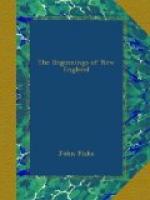Charles’s defence of the Quakers was due, neither to liberality of disposition nor to any sympathy with them, but rather to his inclinations toward Romanism. Unlike in other respects, Quakers and Catholics were alike in this, that they were the only sects which the Protestant world in general agreed in excluding from toleration. Charles wished to secure toleration for Catholics, and he could not prudently take steps toward this end without pursuing a policy broad enough to diminish persecution in other directions, and from these circumstances the Quakers profited. At times there was something almost like a political alliance between Quaker and Catholic, as instanced in the relations between William Penn and Charles’s brother, the Duke of York. [Sidenote: The “King’s Missive”] [Sidenote: Why Charles II. interfered to protect the Quakers]
Besides all this, Charles had good reason to feel that the governments of New England were assuming too many airs of sovereignty. There were plenty of people at hand to work upon his mind. The friends of Gorton and Child and Vassall were loud with their complaints. Samuel Maverick swore that the people of New England were all rebels, and he could prove it. The king was assured that the Confederacy was “a war combination, made by the four colonies when they had a design to throw off their dependence on England, and for that purpose.” The enemies of the New England people, while dilating upon the rebellious disposition of Massachusetts, could also remind the king that for several years that colony had been coining and circulating shillings and sixpences with the name “Massachusetts” and a tree on one side, and the name “New England” with the date on the other. There was no recognition of England upon this coinage, which was begun in 1652 and kept up for more than thirty years. Such pieces of money used to be called “pine-tree shillings”; but, so far as looks go, the tree might be anything, and an adroit friend of New England once gravely assured the king that it was meant for the royal oak in which his majesty hid himself after the battle of Worcester!
Against the colony of New Haven the king had a special grudge. Two of the regicide judges, who had sat in the tribunal which condemned his father, escaped to New England in 1660 and were well received there. They were gentlemen of high position. Edward Whalley was a cousin of Cromwell and Hampden. He had distinguished himself at Naseby and Dunbar, and had risen to the rank of lieutenant-general. He had commanded at the capture of Worcester, where it is interesting to observe that the royalist commander who surrendered to him was Sir Henry Washington, own cousin to the grandfather of George Washington. The other regicide, William Goffe, as a major-general in Cromwell’s army, had won such distinction that there were some who pointed to him as the proper person to succeed the Lord Protector on the death of the latter. He had married Whalley’s




